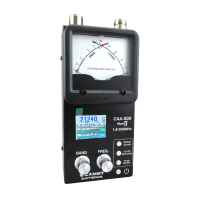
Do you have a question about the Comet CAA-500 MARK II and is the answer not in the manual?
| Brand | Comet |
|---|---|
| Model | CAA-500 MARK II |
| Category | Measuring Instruments |
| Language | English |
Highlights the built-in transmitter, LCD/cross-needle display, band sweeping, battery options, and auto power off.
Warns against dropping, physical shock, external transmitters, strong RF fields, battery issues, and incorrect voltage.
Instructs to discharge static electricity from the antenna system before connecting to the analyzer.
Details the display meter, multi-function display, band knob, freq knob, buttons, RF connectors, and mounting bracket.
Explains the instrument's calibration orientation and provides context for operational examples.
Guides through connecting dummy load, powering on, verifying SWR, and performing measurements.
Details connecting the meter, setting band/frequency, and reading SWR/impedance.
Explains the LCD display of impedance, including absolute value of reactance without polarity.
Describes connecting antenna, rotating FREQ knob to find minimum SWR for resonant frequency.
Explains how to initiate an automatic SWR sweep based on selected band and center frequency.
Details setting custom center frequency, sweep bandwidth, and plotting SWR manually.
Configures the automatic power off timer to preserve battery life after inactivity.
Details trickle charging Ni-MH batteries inside the case and external charging requirements.
Explains common error messages and their potential causes during operation.
Step-by-step guide to recover corrupted internal flash data for the unit.
Addresses shifted resonant frequency, no SWR dip, and low SWR readings with 50-ohm impedance.
Provides advice on using cables for accurate impedance readings and cable length considerations.
Clarifies whether the 'M' and 'N' jacks can be used simultaneously.
Lists key technical details including frequency range, display type, power sources, and dimensions.
Provides contact details for support, warranty claims, and company information.
